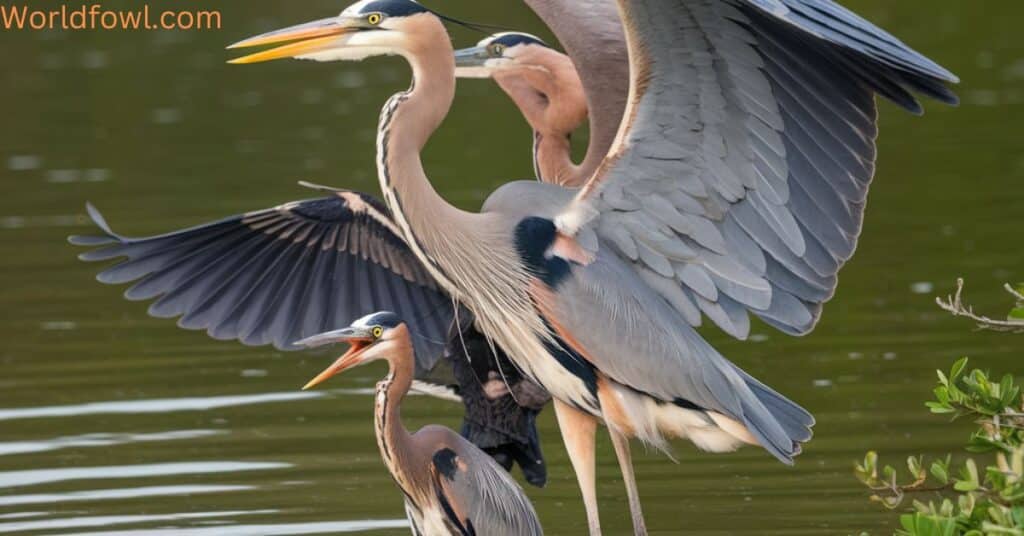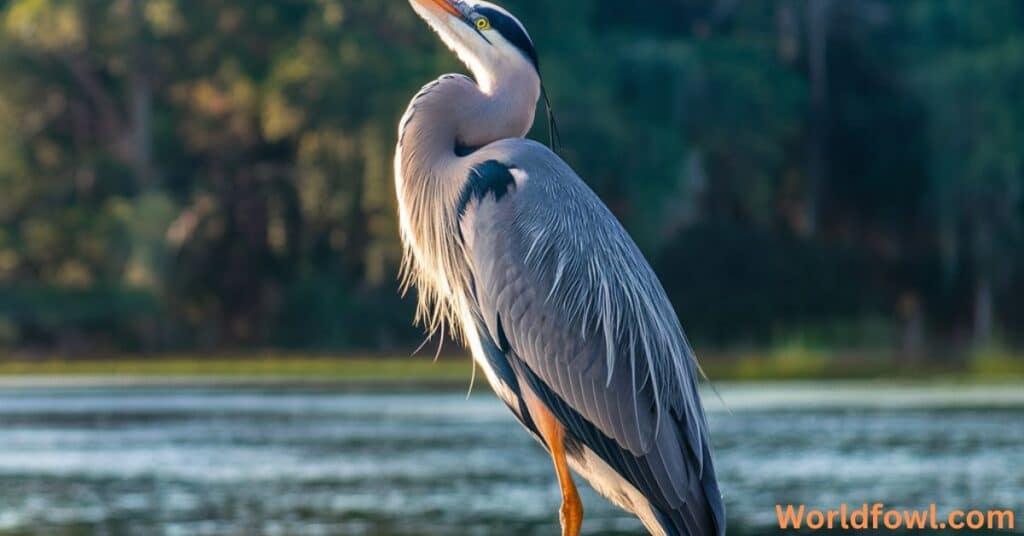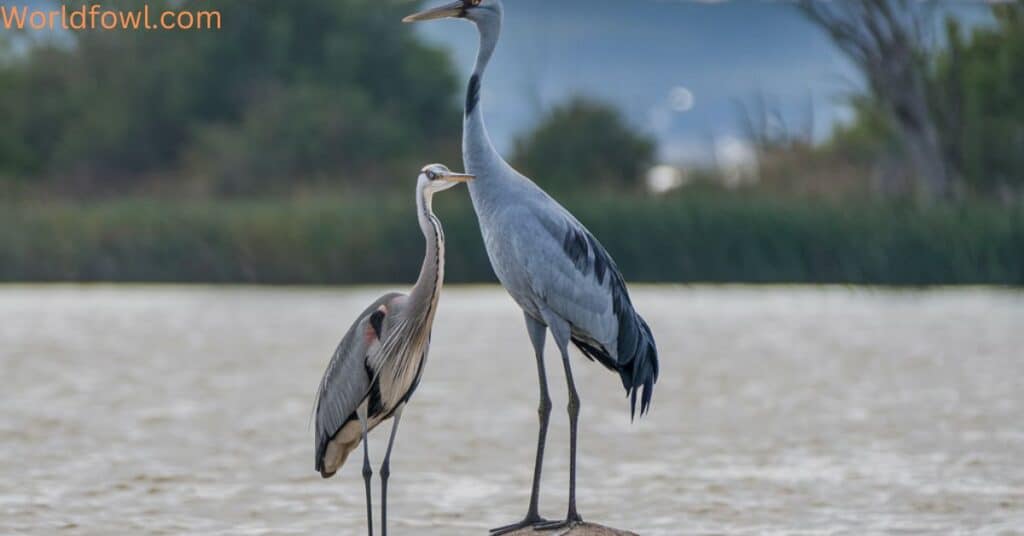In the world of long-legged wading birds, two names often come up: cranes and herons. These elegant creatures grace our wetlands, marshes, and grasslands, captivating birdwatchers and nature enthusiasts alike. But how well do we really know these birds? Are they as similar as they appear at first glance? Let’s dive into the fascinating world of cranes and herons, unraveling their mysteries and celebrating their unique characteristics.
Introduction: The Crane vs Heron Conundrum
When you spot a tall, long-legged bird stalking through shallow waters or standing motionless in a field, you might wonder: Is that a crane or a heron? It’s a common question, and for good reason. These birds share some superficial similarities that can make identification tricky for the untrained eye.
But here’s the thing: cranes and herons are quite different, each with its own set of remarkable traits. Understanding these differences isn’t just a matter of satisfying curiosity. It’s crucial for:
- Accurate wildlife identification
- Conservation efforts
- Appreciating biodiversity
- Understanding ecosystem health
- Enhancing birdwatching experiences
So, let’s embark on this journey to distinguish between cranes and herons, exploring everything from their evolutionary history to their cultural significance.
Taxonomy: Unrelated Cousins
At first glance, cranes and herons might seem like close relatives. But dig a little deeper, and you’ll find they’re more like distant cousins in the avian world.
Heron Family (Ardeidae)

Herons belong to the family Ardeidae, which includes:
- Herons
- Egrets
- Bitterns
This family is diverse, with about 64 species across 17 genera. Some notable members include:
- Great Blue Heron (Ardea herodias)
- Goliath Heron (Ardea goliath)
- Little Egret (Egretta garzetta)
- Black-crowned Night Heron (Nycticorax nycticorax)
- Cattle Egret (Bubulcus ibis)
- Green Heron (Butorides virescens)
Herons have a long evolutionary history, with fossil records dating back to the Paleogene period, about 54-38 million years ago. This ancient lineage has allowed for significant diversification within the family, resulting in a wide range of sizes, colors, and specialized adaptations.
Heron Subfamilies
The Ardeidae family is further divided into subfamilies:
- Ardeinae (typical herons and egrets)
- Botaurinae (bitterns)
- Tigrisomatinae (tiger herons)
- Nycticoracinae (night herons)
Each subfamily has its own unique characteristics and adaptations, contributing to the overall diversity of the heron family.
you may also like : 24 Yellow Birds In Ohio With Photos
Crane Family (Gruidae)

Cranes, on the other hand, belong to the family Gruidae. This family is smaller, with only 15 species across two genera:
- Grus (14 species)
- Balearica (2 species)
Some well-known crane species include:
- Sandhill Crane (Antigone canadensis)
- Whooping Crane (Grus americana)
- Red-crowned Crane (Grus japonensis)
- Demoiselle Crane (Anthropoides virgo)
- Sarus Crane (Antigone antigone)
Cranes have an even more ancient lineage than herons. Fossil records suggest that cranes have been around for about 40-60 million years, evolving during the Eocene epoch. This long evolutionary history has resulted in highly specialized behaviors and adaptations.
Crane Genera
The two genera of cranes are:
- Grus: Includes most crane species, characterized by bare heads and necks
- Balearica: Crowned cranes, distinguished by their golden crown of feathers
“The taxonomic differences between cranes and herons reflect millions of years of separate evolutionary paths, resulting in distinct adaptations and characteristics.” – Dr. Jane Goodall
Evolutionary Convergence
Despite their taxonomic differences, cranes and herons exhibit some similarities due to evolutionary convergence. Both groups have independently evolved long legs and necks as adaptations to wading in shallow waters. This is a classic example of how similar environmental pressures can lead to similar physical traits in unrelated species.
Physical Characteristics: More Than Meets the Eye
While both cranes and herons are tall, long-legged birds, their physical differences become apparent upon closer inspection.
Size Comparisons
Let’s break down the size differences:
| Species | Height | Wingspan | Weight |
| Sandhill Crane | 3-4 feet | 5.5-7.5 feet | 6.5-14 lbs |
| Great Blue Heron | 3.2-4.5 feet | 5.5-6.6 feet | 4.5-5.5 lbs |
| Whooping Crane | 5 feet | 7-8 feet | 15 lbs |
| Goliath Heron | 4.3-5 feet | 6-7.5 feet | 8.8-11 lbs |
| Demoiselle Crane | 2.5-3 feet | 5-6 feet | 4.4-7 lbs |
| Little Egret | 2-2.5 feet | 3.3-4 feet | 0.5-1.3 lbs |
As you can see, cranes are generally larger and heavier than herons, with the Whooping Crane being one of the tallest flying birds in North America. However, there’s considerable variation within each family, with some smaller crane species and larger heron species.
Distinctive Features
- Neck Structure and Posture
- Cranes: Straight necks in flight, often extended
- Herons: S-shaped kink in neck, often retracted in flight
- Bill Shape
- Cranes: Straight, pointed bills, generally shorter than herons’
- Herons: Longer, dagger-like bills, specialized for spearing fish
- Leg Length and Foot Adaptations
- Cranes: Longer legs relative to body size, smaller feet
- Herons: Shorter legs, larger feet with long toes for perching
- Wing Shape
- Cranes: Broader, more rounded wings
- Herons: More pointed wings, adapted for slower flight
- Body Shape
- Cranes: More robust body, often with a distinctive “bustle” of feathers over the tail
- Herons: Generally more slender body shape
you may also like : 8 Owls In Tennessee – The Complete List (With Photos)
Plumage and Coloration
Cranes and herons exhibit different plumage patterns:
- Cranes:
- Often have more uniform coloration
- Some species display striking red patches on the head
- Crowned cranes have distinctive golden head plumes
- Many species have contrasting black and white patterns on wings, visible in flight
- Herons:
- Generally have more varied plumage
- Different colors and patterns on their bodies
- Many species have elaborate breeding plumes
- Some species, like egrets, are predominantly white
Both groups may have different breeding and non-breeding plumages, and juveniles often look different from adults. This variation in plumage can sometimes lead to confusion in identification, especially for inexperienced birdwatchers.
Sensory Adaptations
Both cranes and herons have excellent vision, crucial for hunting and navigation. However, they have some differences in their sensory adaptations:
- Cranes:
- Excellent hearing, important for communication in open habitats
- Some species have bare patches of skin on the face that can change color for communication
- Herons:
- Specialized neck vertebrae allow for the quick “spear-fishing” motion
- Some species have specialized feathers for tactile sensing in murky water
Dietary Habits: What’s on the Menu?
The diets of cranes and herons reflect their adaptations and habitats, showcasing another significant difference between these two groups of birds.
Heron Diet

Herons are primarily piscivores (fish-eaters), but they’re also opportunistic feeders. Their diet includes:
- Fish (primary food source for most species)
- Amphibians (frogs, salamanders)
- Reptiles (small snakes, lizards)
- Small mammals (voles, mice)
- Insects and other invertebrates
- Occasionally small birds
The Great Blue Heron, for example, has been observed eating over 80 different prey species! This dietary flexibility allows herons to thrive in various aquatic environments.
Specialized Feeding Adaptations
Herons have several adaptations that make them efficient predators:
- Bill shape: Long, sharp bills perfect for spearing fish
- Neck structure: S-shaped neck allows for a rapid strike
- Digestive system: Able to handle bones and scales of fish
- Foot structure: Long toes for stability in soft mud or water
Crane Diet

Cranes are more omnivorous, with a diet that varies seasonally and regionally:
- Grains and seeds (especially important during migration)
- Insects and other invertebrates
- Small vertebrates (mice, snakes, etc.)
- Plants and berries
- Tubers and roots
- Occasionally small fish or aquatic invertebrates
Fun Fact: The Sandhill Crane’s diet can consist of up to 95% plant matter during certain times of the year.
Seasonal Diet Variations
Cranes often adjust their diet based on seasonal availability:
- Spring: Increased consumption of invertebrates and small animals for protein during breeding season
- Summer: Mix of plant material and animal prey
- Fall: Higher proportion of grains and seeds to build fat reserves for migration
- Winter: Reliance on agricultural fields and wetlands for grains and aquatic prey
you also like : Do Owls Poop – The Juicy Truth
Hunting and Foraging Techniques
The hunting strategies of cranes and herons are as different as their diets:
- Herons:
- Often stand still or move slowly through shallow water
- Wait to strike at prey with their sharp bills
- Use a variety of techniques including:
- Stand and wait
- Slow stalking
- Canopy feeding (using wings to create shade to attract fish)
- Stirring (using feet to stir up prey)
- Cranes:
- Forage by probing the ground with their bills, often in fields or shallow waters
- Use their bills to dig for tubers and invertebrates
- Some species, like the Brolga, use their bills to turn over rocks in search of prey
- Often forage in family groups, especially outside the breeding season
Feeding Ecology and Ecosystem Impact
The different feeding habits of cranes and herons have significant impacts on their ecosystems:
- Herons: As top predators in many aquatic systems, they help control fish populations and can influence the structure of aquatic communities.
- Cranes: Their omnivorous diet and foraging behavior can help disperse seeds and control insect populations. In agricultural areas, they can sometimes be seen as pests due to their consumption of crops.
Behavior: Actions Speak Louder Than Words
The behavioral differences between cranes and herons are fascinating and reflect their unique evolutionary paths.
Social Structures
- Cranes:
- Highly social, often seen in large flocks, especially during migration
- Form strong family bonds, with young staying with parents for up to a year
- Engage in complex social interactions within flocks
- Herons:
- Generally more solitary, though they may nest in colonies
- Some species, like the Cattle Egret, are more social and often seen in groups
- Colonial nesting provides protection from predators but can lead to competition for resources
Communication
Both groups have complex communication systems:
- Vocalizations
- Cranes:
- Famous for their loud, trumpeting calls, often heard from great distances
- Use a variety of calls for different purposes (alarm, contact, territorial)
- Some species, like the Whooping Crane, have individually distinctive calls
- Herons:
- Generally quieter, with a range of squawks and grunts
- Use different calls for courtship, alarm, and communication between parents and chicks
- Some species, like the Bitterns, have distinctive booming calls
- Cranes:
- Visual Displays
- Cranes:
- Elaborate courtship dances, including jumping, wing-flapping, and bowing
- Use of contrasting wing patterns in flight for communication
- Some species have bare patches of skin that change color for communication
- Herons:
- Less dramatic displays, often involving neck stretching and bill clapping
- Use of breeding plumes in courtship displays
- Some species perform aerial displays during courtship
- Cranes:
Intelligence and Problem-Solving
Cranes, in particular, are known for their intelligence:
- Tool use observed in captive individuals
- Complex social behaviors, including teaching behaviors observed in parents
- Ability to adapt to changing environments, including human-altered landscapes
- Long-term memory, particularly important for migration routes
While herons are also intelligent birds, they haven’t been observed using tools in the same way as cranes. However, they demonstrate:
- Adaptability to urban environments
- Learning and memory in relation to fishing techniques
- Complex decision-making in choosing nesting sites
you also like : Why Are House Sparrows Bad? Reasons and Solutions
Migration Patterns
Migration is another area where cranes and herons show distinct differences:
- Cranes:
- Many species are long-distance migrants
- Often migrate in large, conspicuous flocks
- Some populations have among the longest migrations of any bird species (e.g., Siberian Crane)
- Use specific stopover sites, which are crucial for conservation
- Herons:
- Migration patterns vary greatly among species
- Some are long-distance migrants, while others are resident year-round
- Often migrate individually or in small groups, rather than large flocks
- More flexible in their use of stopover sites
Adaptations to Human Presence
Both cranes and herons have had to adapt to increasing human presence in their habitats:
- Cranes:
- Some species, like the Sandhill Crane, have adapted well to agricultural landscapes
- Others, like the Whooping Crane, remain highly sensitive to human disturbance
- Conservation efforts often focus on protecting migration corridors and breeding grounds
- Herons:
- Many species have adapted to urban environments, nesting in city parks and foraging in urban waterways
- Some, like the Cattle Egret, have expanded their range by following human agricultural activities
- Urban adaptations have led to new challenges, such as entanglement in fishing line and collisions with buildings
Reproduction: Love is in the Air
The mating and breeding behaviors of cranes and herons offer another point of fascinating comparison, showcasing the diverse strategies these birds have evolved.
Crane Mating Rituals

Cranes are renowned for their elaborate courtship dances, which are among the most complex in the bird world:
- Leaping and bowing
- Wing-flapping and head-bobbing
- Synchronized calling
- Tossing sticks or grass
- Running with wings outstretched
These dances serve multiple purposes:
- Strengthening pair bonds
- Territorial defense
- Stress relief
- Mate selection
Cranes are typically monogamous, often forming lifelong pair bonds. This long-term partnership is crucial for their reproductive success, as raising crane chicks requires significant parental investment.
Crane Breeding Cycle
- Pair Formation: Often occurs in non-breeding flocks, sometimes years before first breeding attempt
- Territory Establishment: Pairs defend breeding territories aggressively
- Nest Building: Both partners participate in building ground nests in wetlands
- Egg Laying: Usually 2 eggs, rarely 1 or 3
- Incubation: Both parents incubate for 28-32 days
- Chick Rearing: Chicks are precocial (born relatively mature and mobile) but require parental care for several months
Heron Breeding Behaviors

Herons have less showy, but no less interesting, breeding behaviors:
- Colonial nesting (often in large groups)
- Pair bonding through ritualized displays
- Male “advertising” to attract females
- Bill clapping and neck stretching as part of courtship
Unlike cranes, heron pairs typically form new bonds each breeding season. This strategy allows for more flexibility in mate choice and adaptation to changing environmental conditions.
Heron Breeding Cycle
- Colony Formation: Many species nest in large colonies, often with other heron species
- Nest Site Selection: Males often choose and defend nest sites
- Pair Formation: Through ritualized displays at the nest site
- Nest Building: Both partners participate, often stealing materials from neighboring nests
- Egg Laying: 3-5 eggs typically
- Incubation: Both parents incubate for 25-30 days
- Chick Rearing: Chicks are altricial (born relatively immature and helpless) and require intensive parental care
Nesting Habits and Parental Care
| Aspect | Cranes | Herons |
| Nest Location | Ground, often in wetlands | Trees or reed beds |
| Nest Structure | Simple scrape or mound | Platform of sticks |
| Clutch Size | Usually 2 eggs | 3-5 eggs |
| Incubation Period | 28-32 days | 25-30 days |
| Parental Care | Both parents, up to 10 months | Both parents, 6-8 weeks |
| Chick Development | Precocial | Altricial |
Reproductive Strategies and Success
The different reproductive strategies of cranes and herons reflect their ecological niches and life histories:
- Cranes:
- Lower reproductive rate (fewer eggs, less frequent breeding)
- Higher parental investment per offspring
- Longer period of juvenile dependency
- Strategy suited for long-lived species in stable environments
- Herons:
- Higher reproductive rate (more eggs, annual breeding)
- Shorter period of parental care
- Faster maturation of young
- Strategy suited for adapting to more variable environments
These different strategies have implications for conservation. Crane populations are often more vulnerable to disturbance due to their lower reproductive rate, while heron populations can often recover more quickly from short-term disturbances.
Habitat and Distribution: Home Sweet Home
The habitats and global distribution of cranes and herons offer insights into their adaptations and ecological roles, as well as the conservation challenges they face.
Preferred Ecosystems
Both cranes and herons are associated with wetlands, but their specific habitat preferences differ:
- Cranes:
- Open grasslands
- Shallow wetlands
- Agricultural fields
- Tundra (for some species)
- Savannas
- Herons:
- Marshes
- Swamps
- Shorelines
- Rivers and lakes
- Mangrove forests
- Rice fields and other human-made wetlands
Global Distribution Patterns
Cranes and herons have different distribution patterns:
- Cranes:
- Found on all continents except Antarctica and South America
- Many species are migratory
- Some of the longest migrations in the bird world (e.g., Siberian Crane)
- Several species have very restricted ranges (e.g., Whooping Crane)
- Herons:
- More widely distributed
- Found on all continents except Antarctica
- Many species are resident (non-migratory)
- Some species have expanded their ranges due to human activities (e.g., Cattle Egret)
Notable Distribution Facts
- The Sandhill Crane has one of the largest ranges of any crane species, breeding from Siberia to Cuba.
- The Great Blue Heron is found throughout most of North and Central America, with some populations in the Galápagos Islands.
- The Grey Heron, a close relative of the Great Blue Heron, is widespread across Europe, Asia, and parts of Africa.
- The Sarus Crane, the tallest flying bird in the world, is found in parts of the Indian subcontinent, Southeast Asia, and Australia.
Habitat Specialization
Some species show remarkable habitat specialization:
- The Wattled Crane is highly dependent on papyrus swamps in Africa.
- The Agami Heron is specialized for life in the dense vegetation of tropical rainforest streams.
- The Black-crowned Night Heron has adapted to a nocturnal lifestyle, often roosting in trees during the day.
Conservation Status and Habitat Threats
Both groups face conservation challenges:
- Habitat loss due to wetland drainage and development
- Climate change affecting migration patterns and breeding grounds
- Hunting and human disturbance
- Pollution and contamination of wetlands
Case Study: The Whooping Crane
- Nearly extinct in the 1940s (only 21 wild birds remained)
- Intensive conservation efforts have increased the population to over 500
- Still critically endangered, showcasing the fragility of crane populations
Case Study: The Goliath Heron
- Largest heron in the world
- Vulnerable to habitat loss an
Evolutionary History: A Tale of Two Lineages
The evolutionary histories of cranes and herons provide fascinating insights into how these birds have adapted to their environments over millions of years.
The Ancient Origins of Cranes
Cranes are often referred to as “living fossils” due to their ancient lineage. The oldest known crane fossil, Palaeogrus princeps, dates back to the Eocene epoch, approximately 54.8 to 33.9 million years ago. This suggests that cranes have been a distinct group for an impressively long time.
Some key points in crane evolution:
- Early cranes were likely more adapted to forested environments, unlike their modern grassland-dwelling descendants.
- The diversification of crane species coincided with the spread of grasslands and wetlands during the Miocene epoch (23-5.3 million years ago).
- Modern crane genera emerged around 10 million years ago, with species-level diversification occurring more recently.
Heron Evolution: A More Recent Tale

While still ancient by human standards, herons have a more recent evolutionary history compared to cranes. The earliest known heron fossils date back to the Paleogene period, about 54-38 million years ago.
Interesting aspects of heron evolution include:
- The evolution of the unique “kink” in the heron’s neck, which allows for their characteristic rapid strike when hunting.
- Diversification of heron species seems to have accelerated during the Miocene epoch, similar to cranes.
- The evolution of different feeding strategies led to the variety of bill shapes and sizes seen in modern herons.
“The evolutionary paths of cranes and herons showcase nature’s ability to produce diverse adaptations from similar starting points.” – Dr. Richard Prum, Ornithologist
Anatomical Adaptations: Form Follows Function
The physical differences between cranes and herons are not just superficial; they reflect deep-seated adaptations to different ecological niches.
Bill Structure and Feeding Adaptations
Crane Bills:
- Generally shorter and more robust
- Adapted for probing soil and vegetation
- Some species (like the Sarus Crane) have serrated edges for gripping slippery prey
Heron Bills:
- Longer and more dagger-like
- Specialized for spearing fish and other aquatic prey
- Some species (like the Boat-billed Heron) have evolved unique bill shapes for specific feeding strategies
Leg and Foot Adaptations
Cranes:
- Longer legs relative to body size
- Adapted for walking in grasslands and shallow water
- Smaller feet with shorter toes, suitable for terrestrial locomotion
Herons:
- Shorter legs relative to cranes
- Large feet with long toes for perching and navigating aquatic vegetation
- Some species have specialized scales on their feet to prevent slipping on wet surfaces
you may also like : Do Vultures Attack Humans? Here’s What You Need To Know
Flight Adaptations
Both cranes and herons are accomplished flyers, but with different specializations:
Cranes:
- Long, broad wings adapted for soaring flight
- Ability to use thermals for long-distance migration
- Extended necks and legs during flight
Herons:
- Broader wings relative to body size
- Adapted for slower, more maneuverable flight in forested or wetland areas
- Retracted necks during flight
Sensory Capabilities: More Than Meets the Eye
The sensory abilities of cranes and herons are finely tuned to their respective lifestyles and hunting strategies.
Vision
Both groups have excellent vision, but with different specializations:
Cranes:
- Wide field of view, crucial for detecting predators in open habitats
- Good color vision, helpful for finding food in varied landscapes
Herons:
- Binocular vision for precise depth perception when striking at prey
- Ability to see in low light conditions for dawn and dusk feeding
Hearing
Hearing plays a crucial role in communication for both groups:
Cranes:
- Excellent hearing, used for long-distance communication
- Complex vocalizations for pair bonding and flock coordination
Herons:
- Good hearing, particularly attuned to underwater sounds
- Less reliant on vocalizations compared to cranes
Other Senses
- Touch: Both groups have sensitive bills used for locating prey by touch.
- Taste: Less developed in both groups compared to other senses.
Cognitive Abilities and Intelligence
Recent research has shed light on the impressive cognitive abilities of both cranes and herons.
Problem-Solving Skills
Cranes:
- Demonstrated tool use in captivity (e.g., using sticks to reach food)
- Ability to solve multi-step problems
Herons:
- Use of bait to lure fish (observed in Green Herons)
- Adaptability in hunting techniques based on prey behavior
Social Intelligence
Cranes:
- Complex social structures with recognized hierarchies
- Long-term pair bonding requiring sophisticated social cognition
Herons:
- Navigation of complex colonial nesting arrangements
- Some species show cooperative feeding behaviors
Memory and Learning
Both groups show impressive memory and learning capabilities:
- Ability to remember migration routes over thousands of miles
- Learning and adapting to new food sources in changing environments
Migration Marvels: Epic Journeys
The migration patterns of cranes and herons are some of the most impressive in the avian world.
Crane Migrations: Long-Distance Champions

Cranes are known for their spectacular long-distance migrations:
- Siberian Crane: Migrates up to 10,000 miles round trip between Siberia and India
- Sandhill Crane: Large flocks gather in staging areas like Nebraska’s Platte River
- Whooping Crane: Entire wild population migrates between Texas and Canada
Crane migration facts:
- Can fly at altitudes over 30,000 feet
- Use a combination of powered flight and soaring on thermals
- Some individuals live over 30 years, making the same journey dozens of times
Heron Migrations: Varied Strategies

Heron migration patterns are more diverse:
- Great Blue Heron: Partial migrant, with northern populations moving south for winter
- Black-crowned Night Heron: Some populations migrate, others are resident year-round
- Cattle Egret: Known for dispersive migration, expanding its range globally
Interesting heron migration facts:
- Some species migrate individually rather than in flocks
- Nocturnal migration is common in many heron species
- Juvenile herons often disperse far from their birth sites
Conservation Challenges and Successes
Both cranes and herons face significant conservation challenges, but there have also been notable successes.
Threats to Crane and Heron Populations
- Habitat Loss: Draining of wetlands and conversion of grasslands to agriculture
- Climate Change: Altering migration patterns and breeding grounds
- Pollution: Particularly affects fish-eating herons
- Human Disturbance: Affecting breeding and feeding areas
Conservation Success Stories
Crane Conservation:
- Whooping Crane recovery from near-extinction
- International cooperation for migratory crane protection (e.g., China-Russia-Mongolia agreement for Siberian Crane)
Heron Conservation:
- Recovery of Great Blue Heron populations in North America
- Successful reintroduction of Cattle Egrets to new areas
Ongoing Conservation Efforts
- Habitat Protection and Restoration
- Creation and maintenance of protected wetlands
- Restoration of degraded grasslands
- International Cooperation
- Flyway conservation agreements for migratory species
- Collaborative research efforts
- Public Education and Engagement
- Birdwatching tours and festivals promoting awareness
- Citizen science projects monitoring populations
- Captive Breeding and Reintroduction Programs
- Successful for several crane species
- Less common but occasionally used for rare heron species
Cultural Impact: Birds in Human Imagination
Cranes and herons have left an indelible mark on human cultures worldwide.
Cranes in Culture

- East Asian Symbolism
- Symbol of longevity and good fortune
- Prominent in art, literature, and folklore
- Native American Traditions
- Often associated with leadership and good oration
- Modern Cultural References
- Inspiration for martial arts moves (e.g., “crane technique” in karate)
- Symbols of conservation efforts and environmental awareness
Herons in Culture

- Ancient Egyptian Mythology
- Associated with creation and the origin of life
- The Bennu bird, often depicted as a heron, was a symbol of resurrection
- European Heraldry
- Herons featured in coats of arms, symbolizing vigilance and loyalty
- Japanese Art and Literature
- Frequent subject in traditional paintings and haiku poetry
- Symbolizes patience and nobility
The Future of Crane and Heron Research
As our understanding of these birds grows, new areas of research are emerging:
- Genomic Studies
- Investigating genetic diversity in wild populations
- Understanding the genetic basis of migration behavior
- Climate Change Impacts
- Modeling future habitat changes
- Studying adaptability to changing environments
- Advanced Tracking Technologies
- Using GPS and satellite tracking to map detailed migration routes
- Studying fine-scale habitat use and behavior
- Cognitive Research
- Exploring problem-solving abilities and tool use
- Investigating social cognition and communication
- Conservation Technology
- Developing new methods for habitat restoration
- Using drones and AI for population monitoring
Ecotourism and Citizen Science: Engaging the Public
The charisma of cranes and herons has created unique opportunities for public engagement in conservation and research.
Crane and Heron Ecotourism

- Migration Spectacles
- Sandhill Crane migration in Nebraska’s Platte River Valley
- Red-crowned Crane viewing in Hokkaido, Japan
- Specialized Birdwatching Tours
- Whooping Crane tours in Texas
- Heron rookery visits in various locations
- Photography Workshops
- Specialized tours for wildlife photographers
- Opportunities to capture unique behaviors and landscapes
Citizen Science Initiatives
- eBird
- Global platform for recording bird sightings
- Valuable data source for researchers and conservationists
- Breeding Bird Surveys
- Annual surveys involving volunteers across North America
- Crucial for monitoring population trends
- Heron and Egret Observatory Program
- Citizen-led monitoring of heron and egret colonies
- Provides long-term data on breeding success and habitat use
Conclusion:
As we conclude our extensive exploration of cranes and herons, it’s clear that these birds are far more than just tall, long-legged waders. They are evolutionary marvels, ecological indicators, and cultural icons. The crane vs heron comparison reveals not just differences, but a fascinating spectrum of adaptations to various niches within wetland and grassland ecosystems.
Key takeaways from our in-depth look at cranes and herons:
- Evolutionary Resilience: Both groups have survived millions of years of change, adapting to shifting landscapes and climates.
- Ecological Importance: As top predators and prey, they play crucial roles in maintaining ecosystem balance.
- Behavioral Complexity: From elaborate mating dances to sophisticated hunting techniques, these birds exhibit remarkable behaviors.
- Conservation Challenges: Their dependence on specific habitats makes them vulnerable to human-induced changes, but also flags them as important conservation priorities.
As we face unprecedented global changes, the stories of cranes and herons serve as both warnings and inspirations. Their ability to adapt over millions of years gives hope, while their current vulnerabilities highlight the urgent need for conservation action.
Whether it’s the graceful silhouette of a heron patiently hunting in a misty marsh, or the trumpeting call of cranes echoing across a crisp autumn sky, these birds connect us to something ancient and vital in nature. By understanding and appreciating the differences and similarities between cranes and herons, we gain not just ornithological knowledge, but a deeper appreciation for the intricate web of life on our planet.

Henry James is a seasoned blogger and a passionate storyteller on “World Fowl.” With years of experience crafting engaging content, he brings a unique blend of expertise and creativity to his writing. Henry specializes in exploring diverse topics with depth and clarity, captivating readers worldwide.







